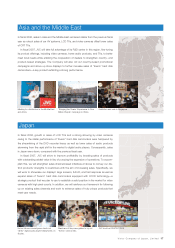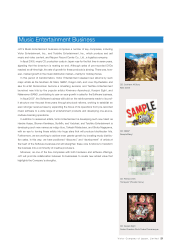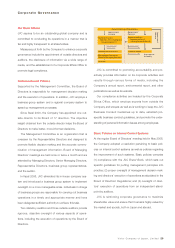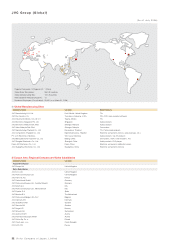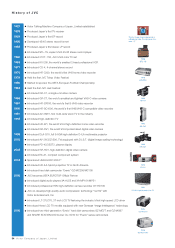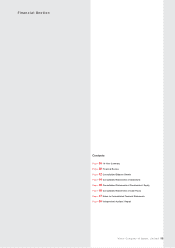JVC 2006 Annual Report Download - page 27
Download and view the complete annual report
Please find page 27 of the 2006 JVC annual report below. You can navigate through the pages in the report by either clicking on the pages listed below, or by using the keyword search tool below to find specific information within the annual report.
A3.9 million as a result of the February 2003 implementation of
the EU’s Waste Electrical and Electronic Equipment (WEEE) recy-
cling directive. Going forward, we will work to reduce our recy-
cling costs through further improvements in resource efficiency.
2. Clean Factories
At JVC, factories that meet certain standards pertaining to the
prevention of global warming, the reduction of waste, the reduc-
tion of chemical emissions, the effective use of water resources,
and other environmental initiatives are designated “clean facto-
ries.” All of our clean factories have achieved the targets set out
in Green Plan 2010, with the exception of objectives pertaining
to the reduction of chemical emissions.
1) Factory-based measures to conserve energy and prevent
global warming
Under Green Plan 2010, JVC established the target of reducing
the annual CO2emissions of its factories 10% from the fiscal
2001 level by fiscal 2011. In fiscal 2006, we curbed emissions
14%, substantially exceeding our target years ahead of plan.
Going forward, we will continue to work to maintain this level.
2) Logistics-based energy conservation
In fiscal 2007, measures to reduce CO2emissions generated via
logistics activities will go into full swing with the enforcement of
Japan’s Revised Energy Conservation Law. To date, we have
taken steps to revise shipping methods, including promoting the
direct shipment of containers from overseas to their final desti-
nation and the employment of cooperative distribution with other
companies, and have strived to improve load efficiency by mini-
mizing the use of packaging materials, changing to better
modes of packing, and increasing the number of pallet stacks.
In addition, we have been working to ascertain the amount of
CO2emissions generated through logistics activities and make
this information visible as part of efforts to gain a clear under-
standing of distribution activities as a whole so that we can form
plans for the reduction of CO2emissions.
3) Waste reduction
In fiscal 2006, JVC reduced the total volume of waste generated
by the Group in Japan, including waste generated by affiliates, a
substantial 81.9% from the previous fiscal year. This accom-
plishment is primarily attributable to the use of an in-house
developed process to detoxify effluent discharged from the
Head Office’s Yokohama Factory during the board production
process, enabling the effluent, which was previously outsourced
for treatment, to be released into Tokyo Bay. This development
not only signifies progress with regard to effluents; it also repre-
sents a substantial reduction in the Company’s environmental
impact. In addition, JVC achieved a recycling rate of 99.6%.
Team Minus 6%
As a participant in “Team Minus 6%,” a national project to pre-
vent global warming, JVC is working to help achieve a 6%
reduction in greenhouse gas emissions. The Company’s efforts
include the conservative use of air conditioning and heating,
allowing employees to wear seasonable attire, conserving water,
turning off neon signs and other lighted displays when not
required, promoting the use of
eco-cars for Company vehicles,
and encouraging employees to
lead environment-friendly lives.
Disclosure of Environmental Information
JVC makes information on its environmental activities available
through its annual Environmental Sustainability Report as well as
the “Environmental Activities” section of its corporate website. In
fiscal 2004, JVC issued its first Environmental Sustainability
Report, available only in paper form in the Japanese language. In
fiscal 2006, the Company launched an English-language version
of the report and began posting an electronic version of the
Japanese-language and English-language Environmental
Sustainability Report on its website.
URL: Japanese language: http://www.victor.co.jp/company/environ/index.html
English language: http://www.victor.co.jp/english/company/environ/index.html
Victor Company of Japan, Limited 25
One concern that people have with large-screen TVs is the electricity bill. However, our HD-ILA hybrid projection TV HD-61MD60 uses
a mere 198 watts of electricity—less than half the electricity used by our 50V plasma TV—and delivers bright, vivid, high-resolution
images.
61V HD-ILA Hybrid Projection TV 40V LCD TV 50V Plasma TV
(198W) (256W) (490W)
Screen brightness 800 candela 500 candela 450 candela
Power
consumption
198W
HD-61MD60
256W
LT-40LC55
490W
PD-50DH50
Team Minus 6% logo




